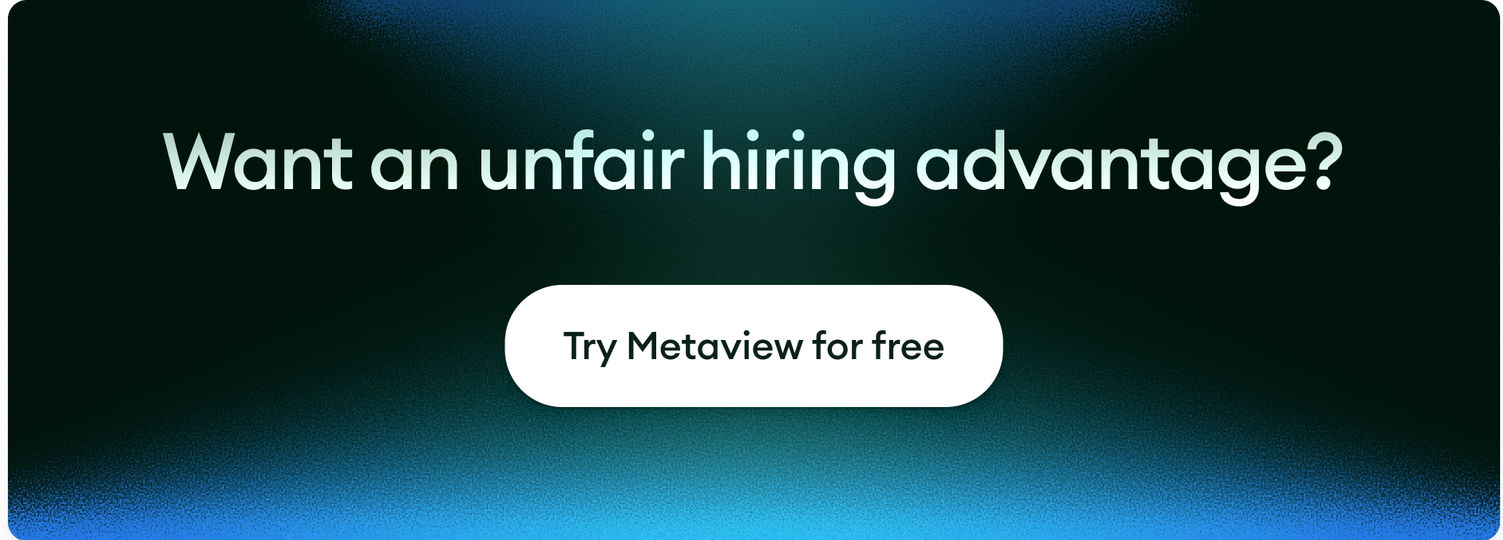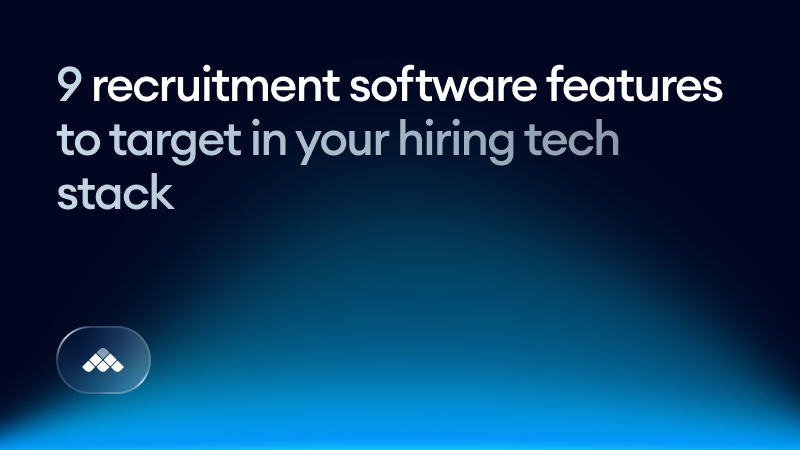Great recruiting has always revolved around people. Your ability to identify, connect with, and convince the best candidates to come on board depends on a keen eye and deep human insight.
But if people are the key to modern recruiting, technology comes a close second. The days of manually tracking candidates in spreadsheets or toggling between disconnected tools are long gone.
Modern recruitment software automates sourcing, structures interviews, captures data, and provides real-time insights that help teams hire smarter and faster.
For HR and recruiting leaders, the challenge isn’t whether to invest in software, but which features actually drive results. With budgets tightening and hiring needs accelerating, your stack must cut wasted effort, eliminate guesswork, and empower your team to focus on high-impact work.
This guide breaks down the 10 most valuable recruitment software features every talent team should have, and how they solve today’s biggest hiring challenges.
3 key takeaways
- The best recruitment software features transform hiring from a manual process into a data-driven strategic function.
- AI and automation free teams from repetitive work so recruiters can focus on relationships and decision-making.
- Integrated systems improve consistency, fairness, and visibility, and are the backbone of a scalable, high-performing talent operation.
What is recruitment software?
Recruitment software is the technology that manages your hiring lifecycle, from sourcing and screening, to interviewing and onboarding. It includes applicant tracking systems (ATS), candidate relationship management tools (CRMs), analytics platforms, and AI-powered solutions that automate tasks once handled manually.
At its best, recruitment software centralizes candidate data, streamlines workflows, and gives every recruiter, hiring manager, and business leader real-time visibility into progress and performance.
Put together, this stack is your source of truth for the entire hiring operation.
What key challenges does recruiting software solve?
Recruiting teams face enormous pressure to move fast and deliver outstanding candidate experiences despite limited time and resources. The right recruitment software directly addresses these core challenges, turning reactive processes into scalable, data-driven systems.
1. Time-consuming sourcing
Finding qualified candidates manually is one of the most time-intensive parts of recruiting. Recruiters often spend hours scanning job boards, profiles, and old resumes just to identify a shortlist.
Great software automates this process with AI sourcing and talent rediscovery features that find candidates continuously, even while you’re offline. The result is a constantly evolving pipeline that ensures you never start from zero.
2. Inconsistent interviews
Without structure and practice, interviews can vary wildly in quality and fairness. Different interviewers may ask unrelated questions, forget to take notes, or make judgments based on instinct rather than evidence.
Recruitment software introduces standardization through structured interview rubrics, automated notetaking, and AI-powered insights. These ensure every candidate is evaluated objectively and consistently.
3. Slow feedback loops
Delays in feedback are one of the most common reasons candidates drop out of hiring processes. When interviewers or hiring managers fail to respond quickly, top candidates often accept offers elsewhere.
Recruitment software prevents this by automating interview summaries, reminders, and centralized dashboards. Feedback is collected and shared instantly, and multi-day lags become same-day decisions.
4. Poor visibility
Recruiting leaders can’t improve what they can’t measure. Without visibility into key metrics like time to hire, conversion rates, or source effectiveness, it’s impossible to identify bottlenecks or prove ROI.
Modern software provides recruitment analytics with real-time clarity on every stage of the funnel. Teams can see what’s working, what’s slowing them down, and how to allocate resources more effectively.
5. Poor candidate experiences
Candidates expect speed, transparency, and professionalism. But when communication is inconsistent or updates go missing, you lose credibility and quickly turn great prospects off joining your team.
Recruitment tools now make it simple to maintain consistent engagement through automated emails, status updates, and feedback messages. The result is a smoother process for candidates, and a stronger employer brand for you.
9 valuable recruiting software features to look for
The right tools transform how your team sources, evaluates, and engages candidates. Provided they have the specific features and capabilities to do so.
As you look for new additions to your recruiting tech stack, prioritize the 10 aspects below. Each of these features plays a specific role in helping you attract, assess, and hire top talent faster.
1. AI notetakers
Manual note-taking during interviews is error-prone, inconsistent, and pulls attention away from the candidate. Recruiters often rely on memory or messy notes to summarize discussions, which leads directly to biased or incomplete feedback.
AI interview notetakers are a lifesaver for recruiters. These tools automatically record, transcribe, and summarize interviews, capturing every detail accurately. Recruiters and hiring managers can focus fully on the conversation, knowing that structured insights will be ready afterward.
- Harriet Ball, Head of Talent, SuperSeed VC
Beyond saving time, these tools build a goldmine of interview data that improves calibration and training over time.
Examples: Metaview (interview intelligence), Fireflies.ai (conversation AI), Fathom (meeting transcription).

2. Automated AI sourcing
Sourcing the right candidates can take up more than half a recruiter’s week, involving endless searches and manual outreach. Automated AI sourcing eliminates that burden.
Using advanced algorithms, these tools continuously scan job boards, professional networks, and talent databases to surface candidates who match your open roles. They can even identify “lookalike” candidates based on your past top performers.
This means your recruiting pipeline stays full automatically, and recruiters have more time to engage top talent instead of hunting for it.
Examples: Metaview (AI sourcing agents), SeekOut (talent discovery), Loxo (AI-powered sourcing CRM).
3. Hiring analytics and reporting
Historically, recruiting data was scattered across spreadsheets or buried in ATS reports. But without accurate data, leaders can’t identify bottlenecks, prove ROI, or improve efficiency.
Hiring analytics tools unify this information, tracking everything from time to fill, to source of hire, to candidate satisfaction. Dashboards help recruiting leaders pinpoint trends, measure performance, and demonstrate their team’s impact.
With data on your side, hiring becomes a continuous cycle of improvement, with far less guesswork.
Examples: Metaview (interview analytics), Ashby (ATS + analytics), Crunchr (HR analytics).
4. Candidate relationship management (CRM)
Recruiters need to build relationships for tomorrow, and not simply fill today’s open roles. A candidate relationship management system helps you stay connected to potential hires even when you’re not actively recruiting.
CRMs centralize candidate interactions, track engagement history, and let you nurture relationships through newsletters, events, or targeted campaigns. When a role opens, you already have a warm pool of qualified, interested candidates.
The result? Faster hires and better fits.
Examples: Beamery (talent CRM), Avature (enterprise CRM), LeverTRM (integrated ATS + CRM).
5. Structured interview tools
Unstructured interviews are one of the biggest sources of bias and inconsistency in hiring. Two interviewers might assess the same candidate in completely different ways.
Structured interview tools bring order and fairness by standardizing questions, scorecards, and rubrics. Everyone evaluates candidates against the same criteria, making feedback easier to compare and decisions more defensible.
This not only improves the quality of hires but also enhances your employer brand. Candidates appreciate fair, organized interview processes and know when you’ve given them a real opportunity to connect.
Examples: Metaview (interview insights), Greenhouse (structured hiring templates), InterviewPlanner (process management).
6. Interview scheduling automation
Few tasks slow recruiters down and add as little value as coordinating interview times. Endless back-and-forth emails can drain hours from every hiring process.
Scheduling automation tools sync directly with calendars and allow candidates to book available slots instantly. They send reminders, manage time zones, and even reschedule automatically if conflicts arise.
What used to take days now happens in minutes, improving both recruiter efficiency and candidate experience.
Examples: GoodTime (automated scheduling), Calendly (calendar sync), Paradox (AI scheduling).
7. Candidate engagement tools
Today’s candidates expect clear, timely communication throughout the hiring process. But when recruiters are stretched thin, follow-ups often slip through the cracks.
Candidate engagement tools automate much of that communication. They send personalized updates, reminders, and nurturing messages at every stage.
This creates a smoother, more human experience at scale. Engaged candidates stay in the process longer and are more likely to accept offers.
Examples: Paradox (candidate communication), Sense (candidate nurturing), Gem (campaign automation).
8. DEI analytics and bias detection
Building diverse teams starts with understanding your current pipeline and identifying where bias may creep in.
DEI analytics tools track diversity metrics throughout the hiring funnel and use AI to flag potential issues in sourcing, screening, and evaluation. Some also analyze job descriptions for biased language or provide inclusive recommendations.
For recruiting leaders, this feature makes diversity measurable, actionable, and continuous.
Examples: SeekOut (diversity analytics), Textio (bias-free job descriptions), Reejig (ethical AI).
9. Seamless integrations
Even the most powerful software loses value if it doesn’t connect with the rest of your stack.
Integration capabilities let your ATS, HRIS, CRM, and analytics platforms communicate seamlessly. Data flows automatically between systems, eliminating manual data entry and ensuring reporting accuracy.
When your tech stack is unified, your hiring process runs smoother, and your team can focus on strategy instead of troubleshooting.
Examples: Workato (workflow integration), Zapier (automation).
How Metaview delivers better recruiting processes
Metaview brings a handful of the most essential recruitment software features discussed above into a single, AI-powered platform, to help talent teams scale hiring quality, not just quantity.
Instead of juggling multiple disconnected tools, recruiting leaders use Metaview to capture, analyze, and act on data from every interview automatically. This turns interviews into structured insights that improve decision-making, interviewer training, and overall hiring consistency.
Get multiple core recruiting features in one place:
- AI interview notetaking: Automatically record, transcribe, and summarize every interview with accurate, structured insights.
- Structured interview tools: Enforce consistency and fairness across interviewers using clear rubrics and scorecards.
- Hiring analytics: Use reporting and insights to track interview quality, candidate trends, and team performance.
- Collaborative feedback dashboards: Centralizes input from recruiters, hiring managers, and stakeholders to speed up decisions.
- Automated AI sourcing: Identify top candidates from across networks using simple job descriptions or prompts.
By integrating these features, Metaview drastically reduces manual admin, eliminates interview inconsistencies, and gives leaders the clarity they need to scale hiring intelligently.
- May Babraitis, CEO, Talent Vine
Get the best tools for your talent team
Recruiting is evolving, and technology needs to evolve with it. The right features make hiring faster, smarter, fairer, and more strategic.
From AI interview notetakers to analytics dashboards, these capabilities form the backbone of a modern, efficient talent acquisition function. When used together, they eliminate repetitive work, improve the candidate experience, and give leaders total visibility into performance.
Ready to modernize your tech stack? Try Metaview for free and see how AI-powered insights can transform your hiring process from end to end.

Recruitment software FAQs
1. What is the most important feature in recruitment software?
The most valuable recruitment software feature depends on your team’s priorities, but automation is often the biggest game changer. Features like AI interview notetaking, automated sourcing, and analytics reduce manual work and free recruiters to focus on high-value tasks such as candidate relationships and decision-making.
2. How do I choose the right recruiting software for my team?
Start by identifying your biggest pain points. If you’re losing time scheduling interviews, focus on automation tools. If quality of hire is your main concern, prioritize structured interview and analytics capabilities. The best recruitment software fits seamlessly into your existing stack, integrates with your ATS or HRIS, and scales as your organization grows.
3. How does AI improve recruiting?
AI supercharges recruiting by automating repetitive tasks and improving decision accuracy. It can source candidates continuously, transcribe and summarize interviews in seconds, and analyze hiring data to uncover bottlenecks or bias. This means recruiters can focus on human interaction, while AI handles the heavy lifting in the background.
4. What impact does recruitment software have on candidate experience?
Modern recruiting tools make the hiring process smoother and more transparent for candidates. Automated updates, faster interview scheduling, and consistent communication reduce frustration and improve engagement.
5. How do integrations improve recruiting software performance?
Integrations connect all your people tools—ATS, HRIS, calendar, and analytics systems—so information flows seamlessly. This eliminates manual data entry, reduces errors, and creates a single source of truth. With everything connected, teams make faster, more informed hiring decisions without switching between platforms.
6. Is recruiting software worth it for small teams or startups?
Yes. Recruitment software reduces admin work, improves coordination, and helps you scale without increasing headcount. Tools like Metaview, Greenhouse, or Ashby are built to be scalable, so you can start small and expand features as your company grows.


